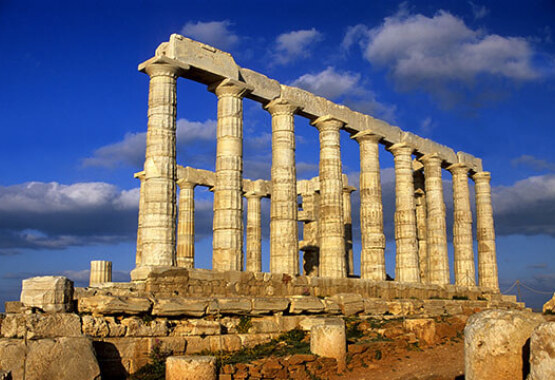
ATHENS
It was entirely built with pentelic marble during the first half of the 1st century B.C. by the Greek astronomer from Kyrros in Macedonia Andronikos Kyrrhestes and it has an octagonal shape. Its height is twelve meters and each side is 3 m. and 20 cm long. There are two entrances on the northeast and northwest sides respectively, where a propyl with two columns at the opposite of each one used to stand, while on the southern side there is a semicylindrical additional lower building. The conical and tiled roof was adorned with a brazen Triton, which served as a weather vane. However the most impressive element of the monument, is, undoubtedly, the eight embossed feathered winds on the metopes’ sides, which bear their own symbol name, which are: Boreas (N), Kaikias (NE), Eurus (E), Apeliotes (SE), Notus (S), Livas (SW), Zephyrus (W) and Skiron (NW).
The monument charmed travelers and historians both for its construction and for its scientific use. It was called the Tower of the Winds or the Temple of Aeolus, and it has been described in detail and classified in two styles; the outer part due to the propyl and the two columns has been classified as Corinthian style while the inner part as Doric style.
Apart from being a meteorological station it was also a clock tower, as there were sundials while on the cloudy days a hydraulic clock was in operation. It is considered that the constructor of the monument combined the inventions of former clock constructors, like Archimedes, Ctisivius and Filon.
During the early Christian years it was converted to a church or baptistery of a neighboring church, while on the space outside the northeastern entrance there was a Christian cemetery. In the 15th c. the monument was referred to as the Temple of Aeolus and in an anonymous traveler’s statement as a church.
The Temple of the Winds was fully unearthed in the 19th c. by the Greek Archaeological Society and the surrounding neighborhood was named after it (“Aerides” meaning winds), which still remains in our days as one of the most picturesque spots of the historic centre of Athens.
Tower of the Winds
The Horologion of Andronikos Kyrrhestes, also known as the Tower of the Winds is one of the most fascinating archeological monuments in Athens that lies in the Roman Agora of Athens, between the quarters of Plaka and Monastiraki. It is considered as the first meteorological station in the world.It was entirely built with pentelic marble during the first half of the 1st century B.C. by the Greek astronomer from Kyrros in Macedonia Andronikos Kyrrhestes and it has an octagonal shape. Its height is twelve meters and each side is 3 m. and 20 cm long. There are two entrances on the northeast and northwest sides respectively, where a propyl with two columns at the opposite of each one used to stand, while on the southern side there is a semicylindrical additional lower building. The conical and tiled roof was adorned with a brazen Triton, which served as a weather vane. However the most impressive element of the monument, is, undoubtedly, the eight embossed feathered winds on the metopes’ sides, which bear their own symbol name, which are: Boreas (N), Kaikias (NE), Eurus (E), Apeliotes (SE), Notus (S), Livas (SW), Zephyrus (W) and Skiron (NW).
The monument charmed travelers and historians both for its construction and for its scientific use. It was called the Tower of the Winds or the Temple of Aeolus, and it has been described in detail and classified in two styles; the outer part due to the propyl and the two columns has been classified as Corinthian style while the inner part as Doric style.
Apart from being a meteorological station it was also a clock tower, as there were sundials while on the cloudy days a hydraulic clock was in operation. It is considered that the constructor of the monument combined the inventions of former clock constructors, like Archimedes, Ctisivius and Filon.
During the early Christian years it was converted to a church or baptistery of a neighboring church, while on the space outside the northeastern entrance there was a Christian cemetery. In the 15th c. the monument was referred to as the Temple of Aeolus and in an anonymous traveler’s statement as a church.
The Temple of the Winds was fully unearthed in the 19th c. by the Greek Archaeological Society and the surrounding neighborhood was named after it (“Aerides” meaning winds), which still remains in our days as one of the most picturesque spots of the historic centre of Athens.




